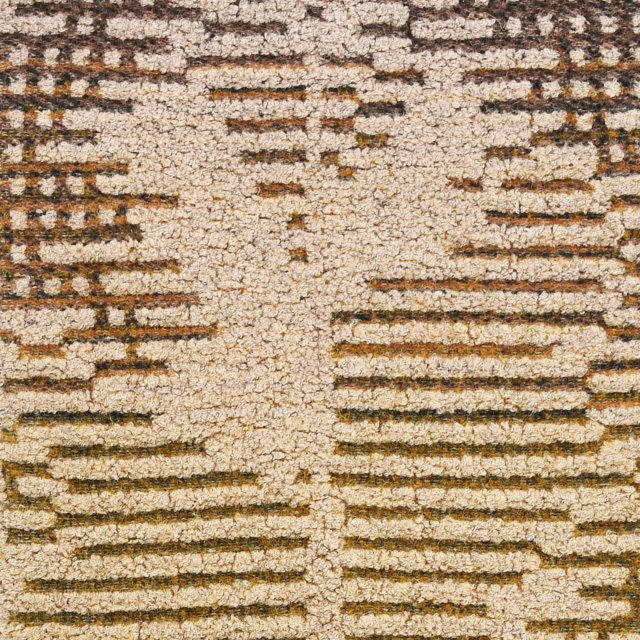‘There is more than enough stuff in this world already'((Brown, S. (2013) Refashioned: cutting-edge clothing from upcycled materials. London: Laurence King Publishing: 9.)), so ‘the challenge for the designer is to make what we have go further, last longer and be more useful and satisfying'((Textiles Futures Research Centre (2014) Ted9. [Vimeo] Available from: http://vimeo.com/107728211 [Accessed 7 Dec 2014].)). The speed and consumption of fashion has become unsustainable, not just with problems in the production chain, but also a sense of dissatisfaction. We have become programmed to think that we need to buy new clothes in order to interact with fashion, however we can update our wardrobes and remain stylish in other ways((Woman’s Hour (2014) BBC Radio 4, 21 April [Online]. Available from: http://katefletcher.com/craft-of-use-on-bbc-radio-4-womans-hour/bbc-r4-womans-hour-kate-fletcher-melanie-rickey/ [Accessed 29 Nov 2014].)). ‘Craft of Use‘((Craft of Use (2014) [Online] Available from: http://craftofuse.org/ [Accessed 27 Nov 2014].)) is a body of work and ideas developed by Kate Fletcher, aiming to challenge the fashion industries dependency on increased material throughput, and aims to propose alternatives that focus attention on the use of our garments((Craft of Use (2014) [Online] Available from: http://craftofuse.org/ [Accessed 27 Nov 2014].)). The current economic system is reliant on consumerism and material consumption, which is depleting the earths resources and increasing wastage. To be sustainable we need to develop an alternative system that promotes quality not quantity and aims ‘to increase value, satisfaction and potential without growing the resources consumed'((Craft of Use (2014) Craft of Use: post-growth economics [Online] Available from: http://craftofuse.org/home/roots/economics [Accessed 22 Dec 2014].)).
‘As people, our many roles change and evolve over the course of a lifetime;
I love the idea that textiles can do the same.’((Chanin, N. (2013) ‘Foreword’. In: Brown, S. Refashioned: cutting-edge clothing from upcycled materials. London: Laurence King Publishing: 7.))
BRICOLAGE is a french term with no exact translation, although ‘tinkering'((Louridas, P. (1999) ‘Design as Bricolage: anthropology meets design thinking’. Design Studies, 20 (6): 517-535.)) is a candidate. It was originally used by Levi-Strauss in 1966 ‘to describe someone who recycles old materials to make do with whatever is at hand”((Lorenzen, J. (2012) ‘Going Green: the process of lifestyle change’. Sociological Forum, 27 (1): 107.)). The bricoleur uses what’s available, attempting to build, repair or change something and figuring things out along the way. ‘Bricolage includes materials and practices from old lifestyles viewed in a new light and recombines them with newly adopted materials, practices and environmental discourses to form a new pattern'((Lorenzen, J. (2012) ‘Going Green: the process of lifestyle change’. Sociological Forum, 27 (1): 107.)). I am interested in working on projects that incorporate found objects that would otherwise be discarded, or damaged items with sentimental value, to produce one-off or limited addition pieces that bring new life to used materials.
MENDING, REMAKING & REUSING extends product life and helps to reduce material consumption. A shift in attitude is needed, moving away from product disposal and towards longevity. Designers are not just responsible for this, it comes down to the choices individuals make and how they choose to live their lives. However, designers play an important role and can help guide users towards making more sustainable decisions, by designing products and setting up systems that promote longevity. ‘Extending the life span of products can also help us balance production and consumption through increased durability, expansion of functional or emotional value, and refurbishment to create another life for a product’((Loker, S. (2008) ‘A technology-enabled sustainable fashion system: fashion’s future’. In: Hethorn, J. and Ulasewicz, C. eds. Sustainable fashion – why now?: a conversation about issues, practices, and possibilities. New York: Fairchild books: 100.)). The key to product durability is about developing an emotional attachment to something, which creates a desire to care for and repair, rather than dispose of and replace. The garments that last are the ones that have a personal connection rather than being made of robust fabrics((Woman’s Hour (2014) BBC Radio 4, 21 April [Online]. Available from: http://katefletcher.com/craft-of-use-on-bbc-radio-4-womans-hour/bbc-r4-womans-hour-kate-fletcher-melanie-rickey/ [Accessed 29 Nov 2014].)).
‘Buy less, choose well, make it last’ – Vivienne Westwood((Guardian Live (2014) Vivienne Westwood on capitalism and clothing: Buy less, choose well, make it last. [YouTube] Available from: https://www.youtube.com/watch?v=cik7qDIBVPk [Accessed 7 Nov 2014].))

Make Do and Mend (cover of 1948 pamphlet). Image from postcard: The Fashion and Textiles Museum (2014) Make Do and Mend [postcard] Knitwear Chanel to Westwood.
MAKE DO AND MEND was a pamphlet issued during the Second World War, ‘intended to provide housewives with useful tips on how to be both frugal and stylish in times of harsh rationing'((British Library (undated) Timelines: sources from history [Online] Available from: http://www.bl.uk/learning/timeline/item106365.html [Accessed 19 Dec 2014].)). Today, dressmaking and mending are skills that have almost died out. Fast fashion has become affordable and it is often more expensive to make your own garments, because of the high cost of fabrics and equipment. Mending also has ‘associations with poverty and need'((Clark, H. (2008) ‘Slow fashion – an Oxymoron – or a Promise for the Future?’. Fashion Theory: the journal of dress, body and culture, 12 (4): 435.)), ‘so it has been, and perhaps still is, socially unacceptable to wear visibly repaired clothing'((Gwilt, A. (2014) A practical guide to sustainable fashion. New York: Fairchild Books: 127.)). However, there have been trends in fashion for aged, worn and distressed fabrics. Visible repairs can be an opportunity for creative expression and individuality, by using decorative techniques. An example of this is Woolfiller((Woolfiller (undated) [Online] Available from: http://www.woolfiller.com/ [Accessed 16 Dec 2014].)), a concept developed by Netherlands based designer Heleen Klopper. She encourages the repair of knitted garments by supplying kits of coloured wool that can be used to fill holes or cover stains, by using a needle punch technique that felts the additional wool to the existing fabric.

Woolfiller – photo from: Gwilt, A. (2014) A practical guide to sustainable fashion. New York: Fairchild Books: 126.
UPCYCLING, ‘the technique of upgrading or adding value to a product or material that may otherwise be discarded'((Gwilt, A. (2014) A practical guide to sustainable fashion. New York: Fairchild Books: 146.)), has become a trend over the last few years amongst small designers. However, this is not a new concept; during the Second World War ‘British women had to find creative ways of recycling garments – one of which was the unravelling of old sweaters. This recycled yarn was then knitted into multicoloured jumpers that made a feature of the variety of wools being re-used'((Fashion and Textile Museum. (2014) Knitwear: Chanel to Westwood. [brochure]. London.)).
NUDIE JEANS((Nudie Jeans (2014) [Online] Available from: http://www.nudiejeans.com [Accessed 14 Dec 2014].)) is a Swedish denim brand with core values in sustainability and longevity. They encourage caring and repairing of their jeans, as well as reuse and recycling. An example of how they have recycled old denim is their collection of rugs and camper seats made from jeans that have been cut into strips and hand woven((Nudie Jeans (2014) Camper seat and recycled rugs presentation [Online] Available from: http://www.nudiejeans.com/shop/camper-seat-and-recycled-rugs-presentation/ [Accessed 14 Dec 2014].)). There is a lot of textile waste in the fashion industry and I really like the idea of reusing fabrics that would otherwise be thrown away. The idea of cutting up used clothing to create a yarn would work well with techniques like hand knitting, crochet or macramé.

Nudie Jeans – camper seat made from recycled jeans. Photo from: Nudie Jeans (2014) Camper seat and recycled rugs presentation [Online] Available from: http://www.nudiejeans.com/shop/camper-seat-and-recycled-rugs-presentation/ [Accessed 14 Dec 2014].

Nudie Jeans – rug made from recycled jeans. Photo from: Nudie Jeans (2014) Camper seat and recycled rugs presentation [Online] Available from: http://www.nudiejeans.com/shop/camper-seat-and-recycled-rugs-presentation/ [Accessed 14 Dec 2014].
BENU BERLIN((Benu Berlin (2014) [Online] Available from: http://www.benu-berlin.com/ [Accessed 17 Dec 2014].)) is a fashion label designed by Karen Jessen. She has also worked with old denim and other materials destined to go to waste. Her collections have reused textiles from old clothing and furniture, such as jeans, t-shirts and leather sofas((Gwilt, A. (2014) A practical guide to sustainable fashion. New York: Fairchild Books: 138.)). Jessen says ‘Jeans and T-shirts are some of the most mass produced garments in the world and also the most thrown away. Transforming old clothes is an effective way of turning this cycle around'((Eco chic design award (2013) Karen Jessen [Online] Available from: http://www.ecochicdesignaward.com/karen-jessen/ [Accessed 21 Dec 2014].)).

Benu Berlin – upcycled jeans. Photo from: Benu Berlin (2014) I want to die with my blue jeans on [Online] Available from: http://www.benu-berlin.com/gallery/8-acts-of-rebellion/ [Accessed 17 Dec 2014].

Benu Berlin – upcycled t-shirts. Photo from: Benu Berlin (2014) I want to die with my blue jeans on [Online] Available from: http://www.benu-berlin.com/gallery/8-acts-of-rebellion/ [Accessed 17 Dec 2014].
RUTH HOLLAND((University of the Arts London (2012) MA 2012 Ruth Holland [Online] Available from: http://showtime.arts.ac.uk/ruthholland [Accessed 15 Dec 2014].)) is a designer who reinvents ‘waste material as elaborate, decorative and powerful fashion accessories.'((Brown, S. (2013) Refashioned: cutting-edge clothing from upcycled materials. London: Laurence King Publishing: 200.)) Her ornate neckpieces for her Masters thesis were made using traditional knotting techniques, out of industrial and domestic electrical waste. Her work ‘raises questions about the transformation of obsolete materials, rather than their disposal'((Brown, S. (2013) Refashioned: cutting-edge clothing from upcycled materials. London: Laurence King Publishing: 203.)).

Ruth Holland – necklaces made from electrical waste. Photo from: University of the Arts London (2012) MA 2012 Ruth Holland [Online] Available from: http://showtime.arts.ac.uk/ruthholland [Accessed 15 Dec 2014].

Ruth Holland – necklaces made from electrical waste. Photo from: University of the Arts London (2012) MA 2012 Ruth Holland [Online] Available from: http://showtime.arts.ac.uk/ruthholland [Accessed 15 Dec 2014].
THE GREAT RECOVERY((The Great Recovery (2014) About us [Online] Available from: http://greatrecovery.org.uk/about-us/ [Accessed 29 Dec 2014].)) aims to raise awareness and form partnerships that can help break our current linear model of ‘take-make-dispose’ and shift towards more circular systems that consider the full lifecycle of products((The Great Recovery (2014) About us [Online] Available from: http://greatrecovery.org.uk/about-us/ [Accessed 29 Dec 2014].)). This video((The Great Recovery (2012) The Great Recovery. [YouTube] Available from: https://www.youtube.com/watch?v=0ExzD-79aXw [Accessed 29 Dec 2014].)) shows the extent of the wastage problem and highlights the challenges within the current system. Designers need to change the way they work, considering the end use of products to allow for a circular system to develop. Remaking and reusing was the focus of this workshop (shown in the below video((The Great Recovery (2014) Jewellery from e-waste and acrylic off cuts. [YouTube] Available from: https://www.youtube.com/watch?v=Y37qwIOd_MI [Accessed 29 Dec 2014].)) ) where people could make jewellery out of leftover materials from laser cutting. As well as raising awareness of wastage problems, it also encourages participation in craft.










